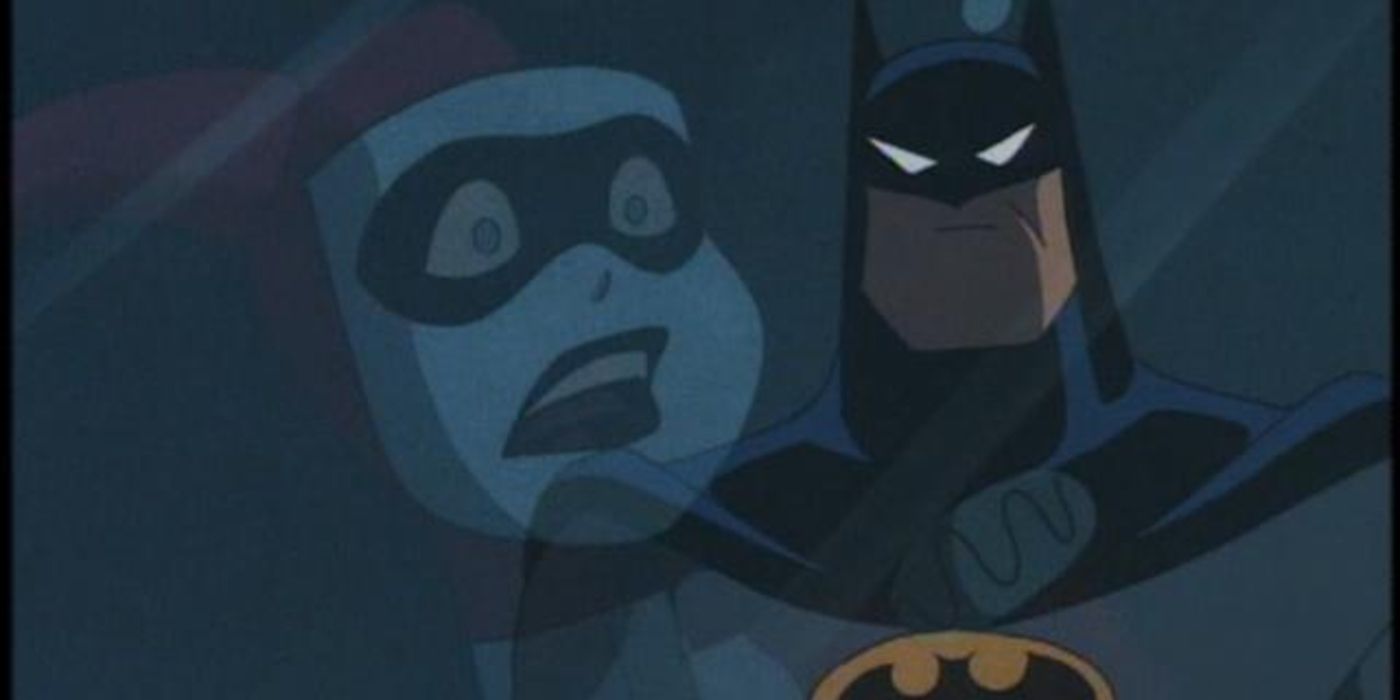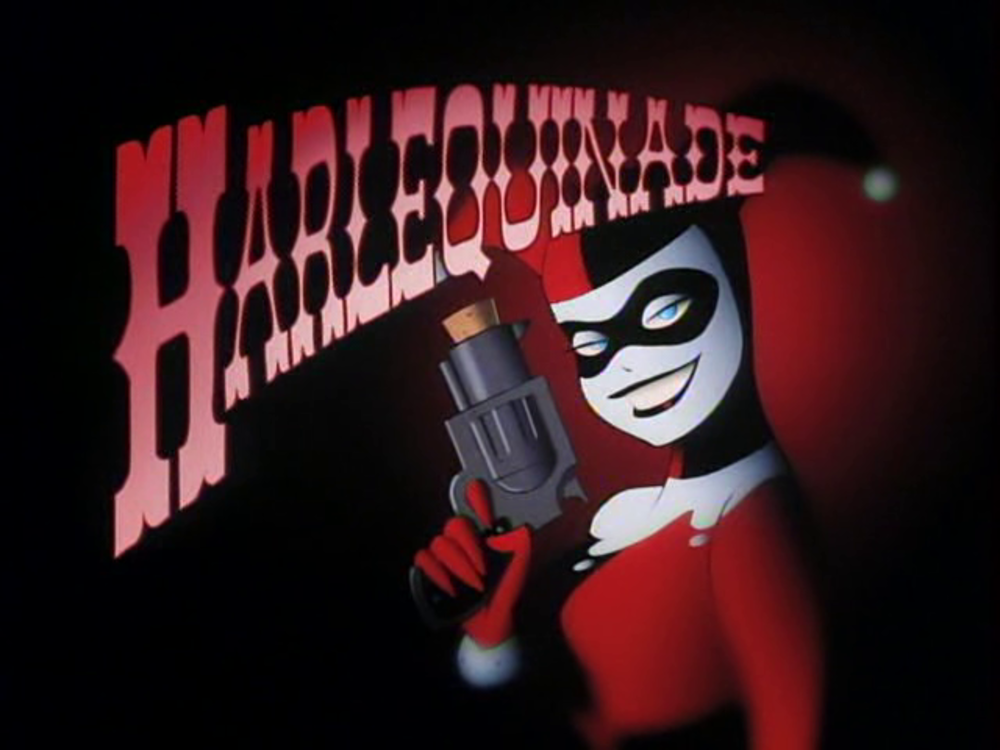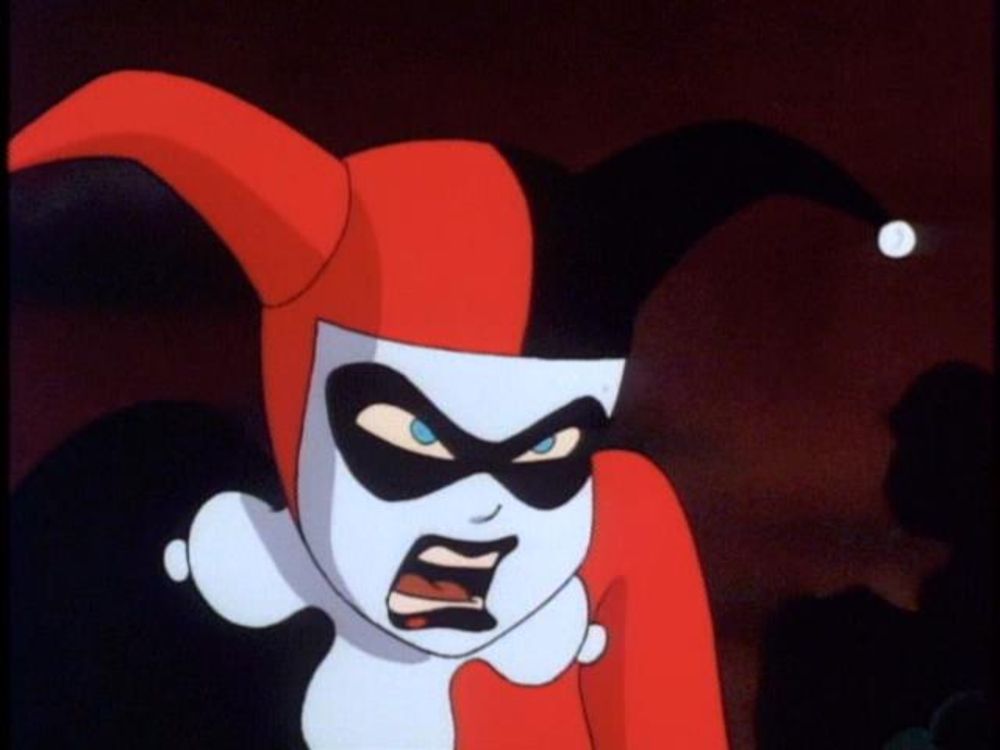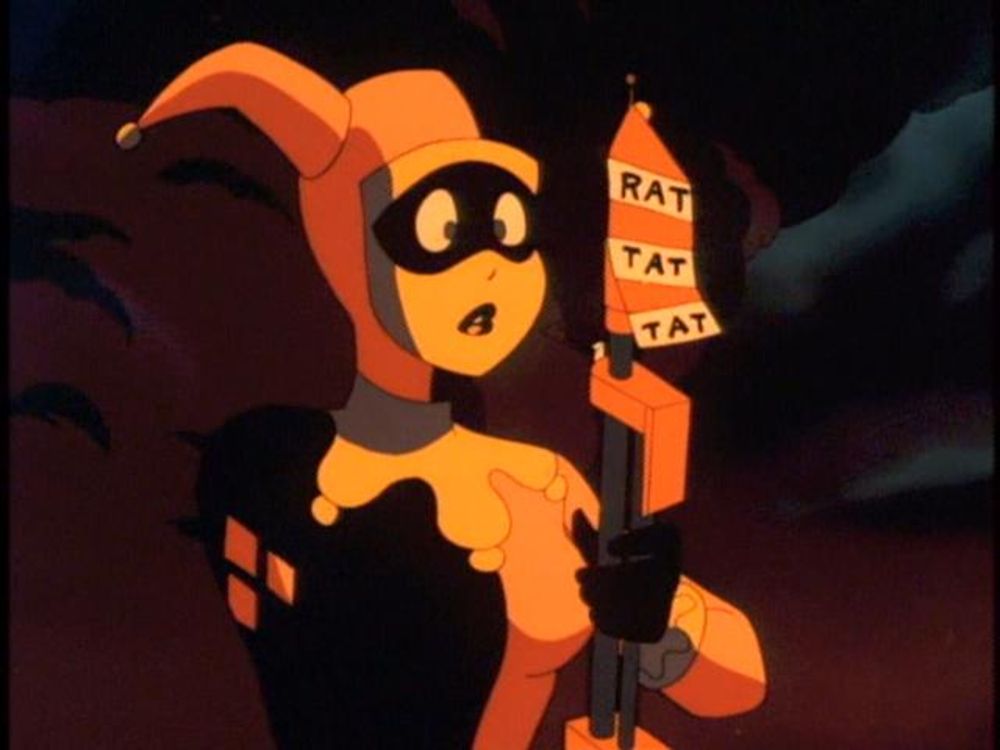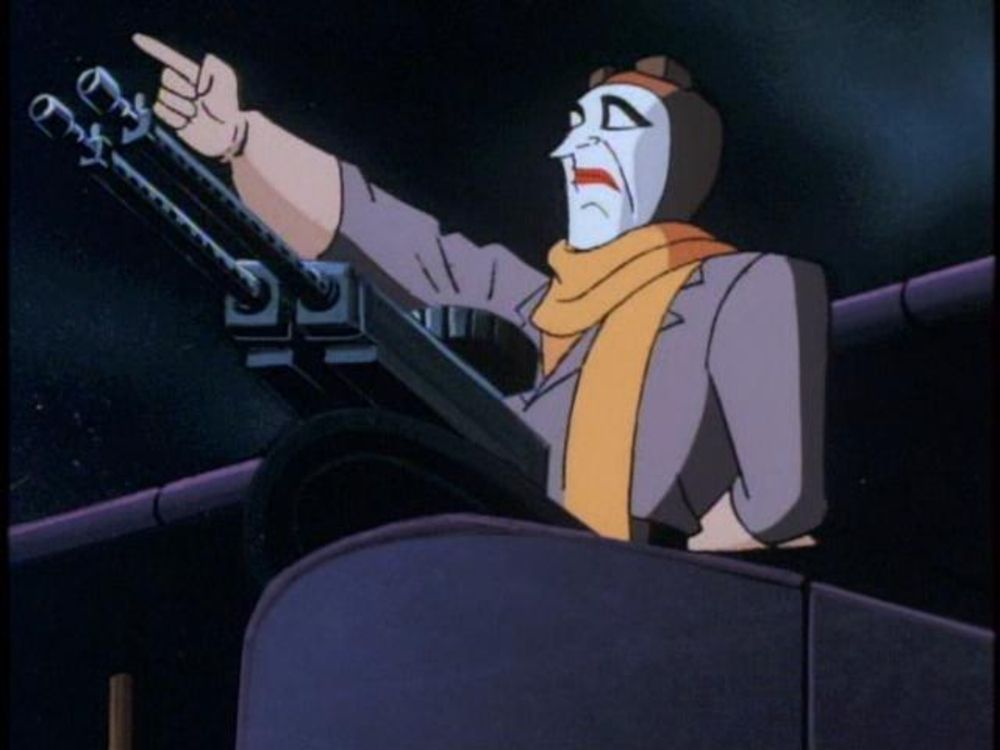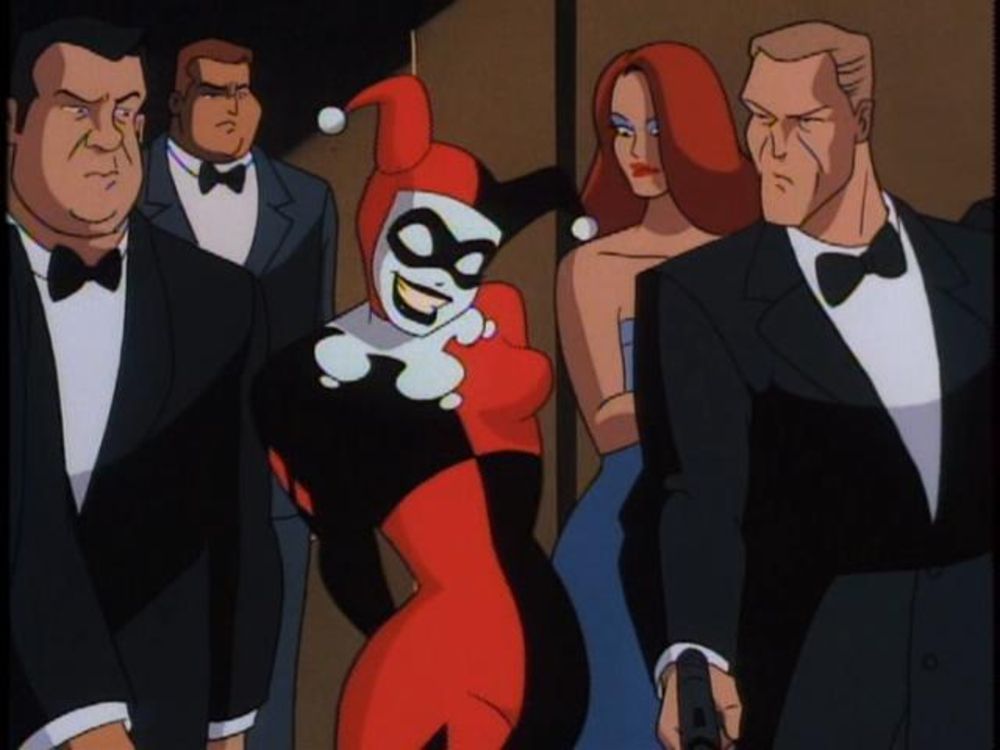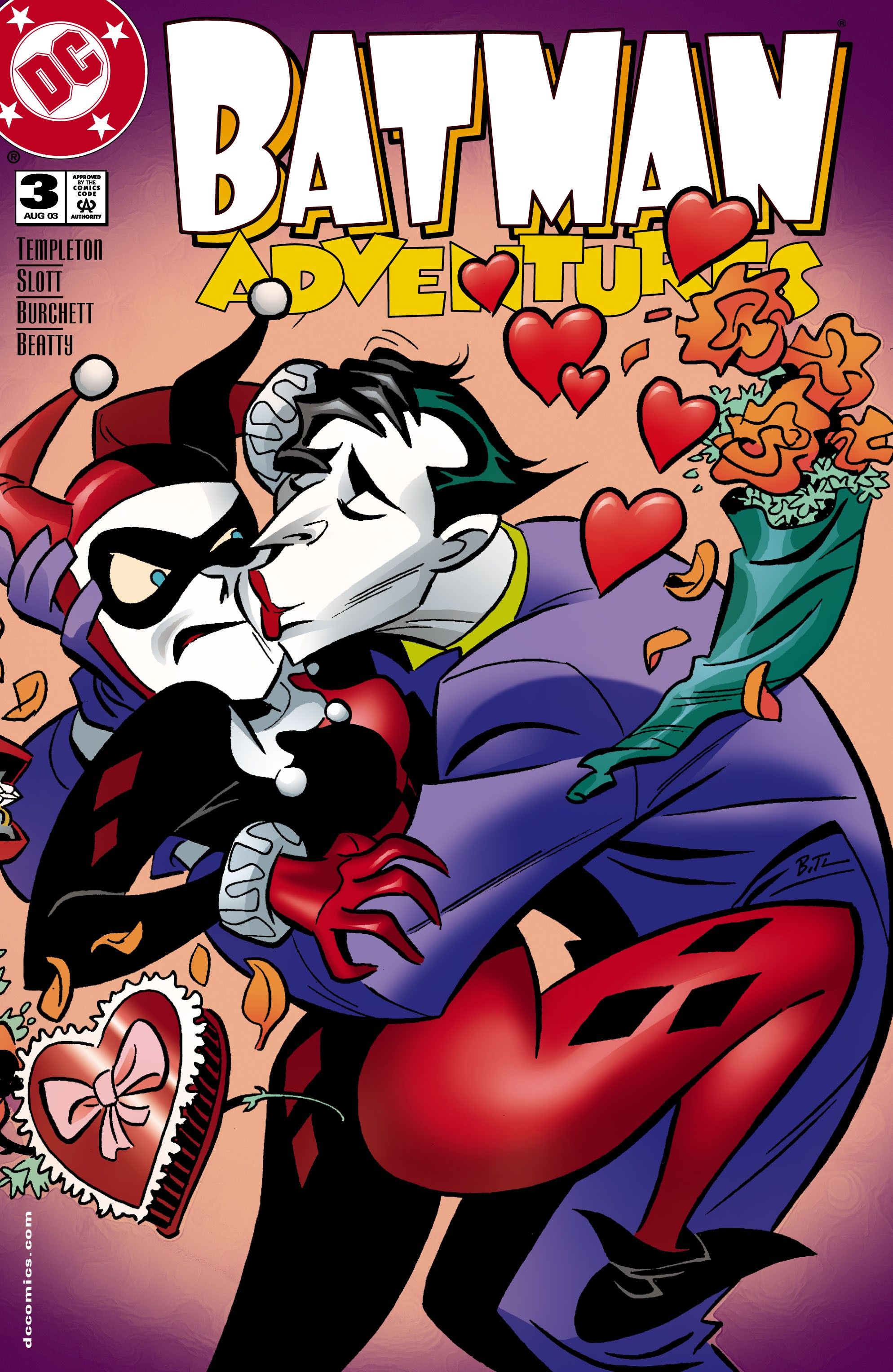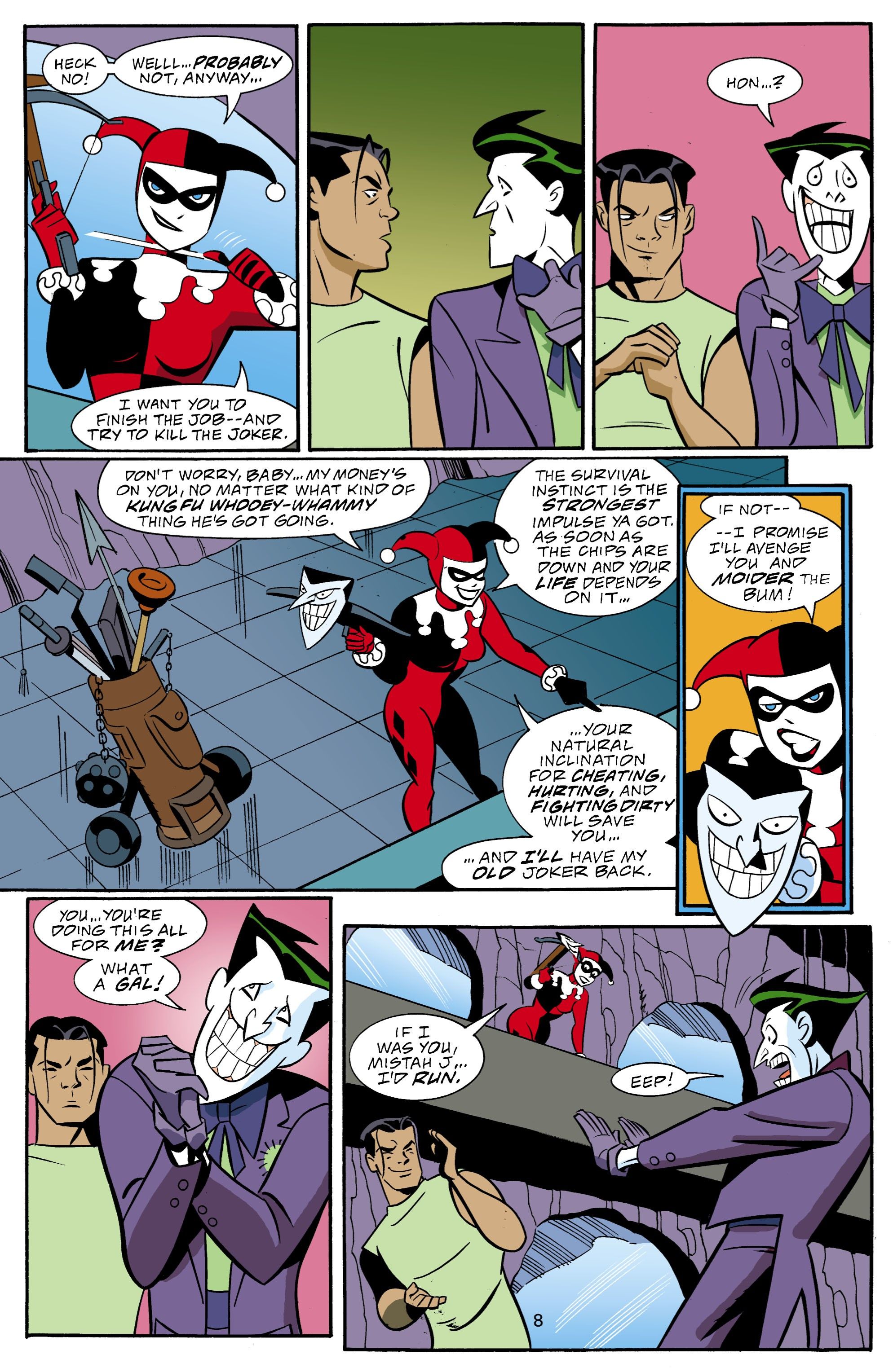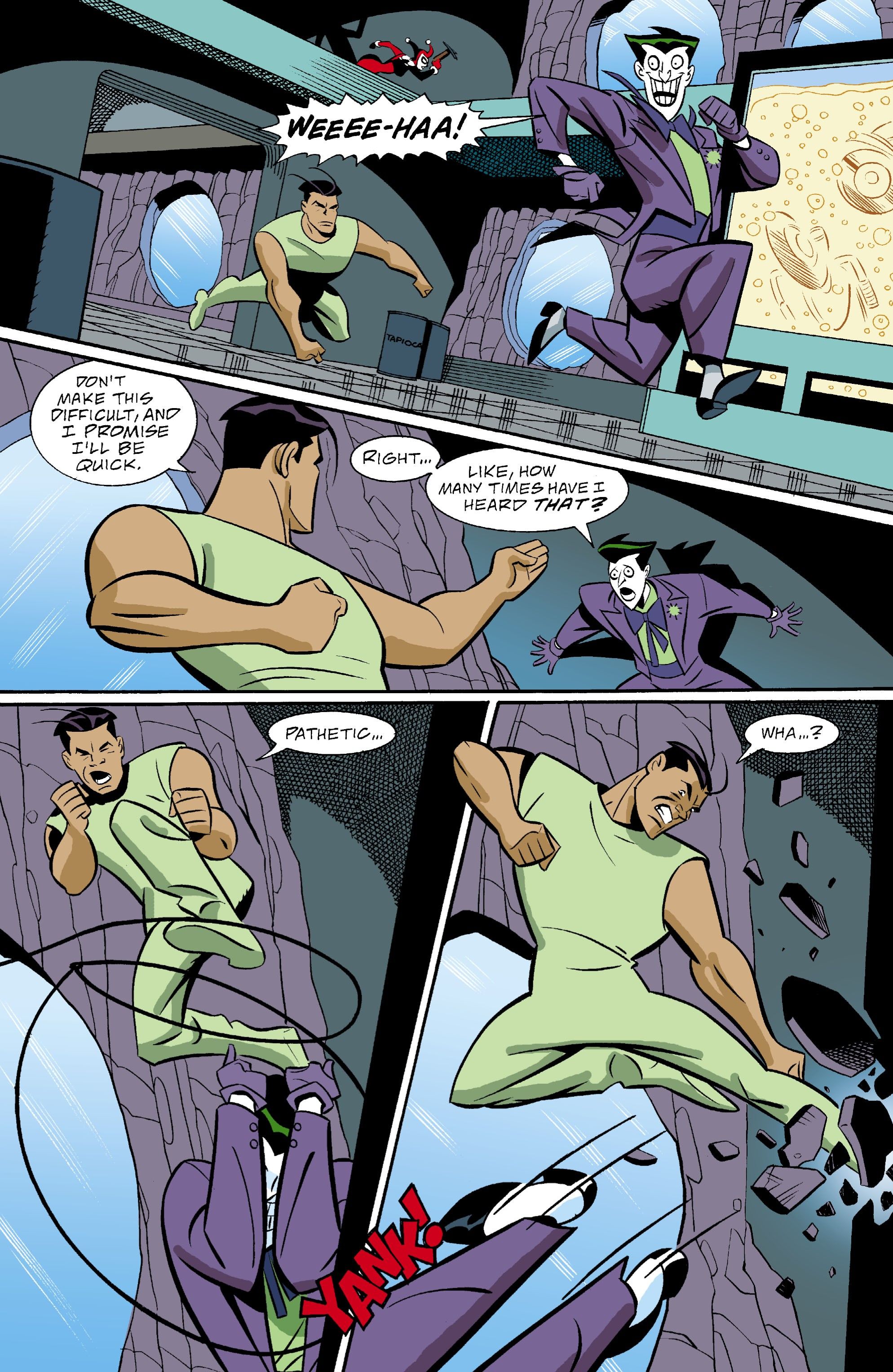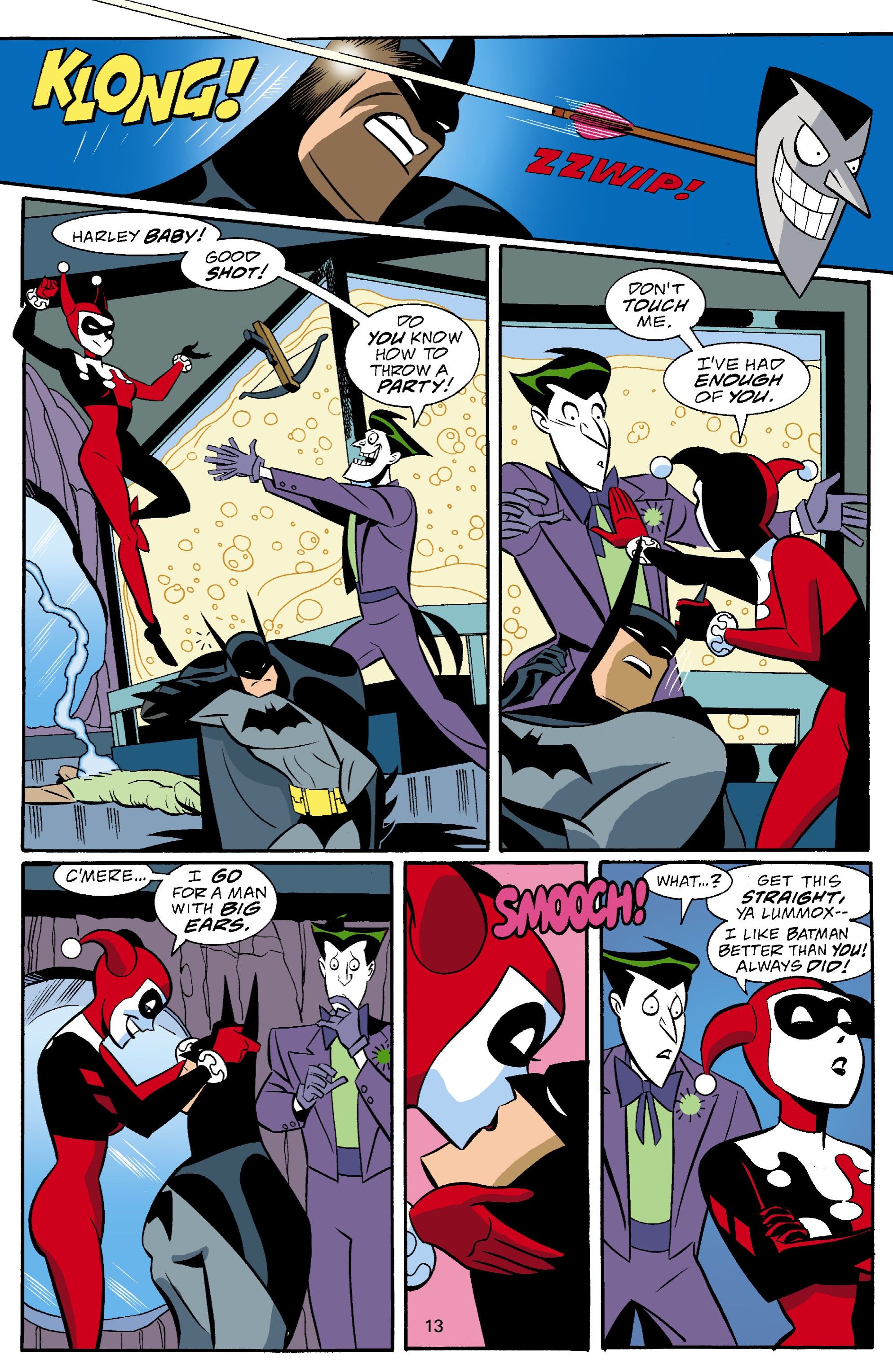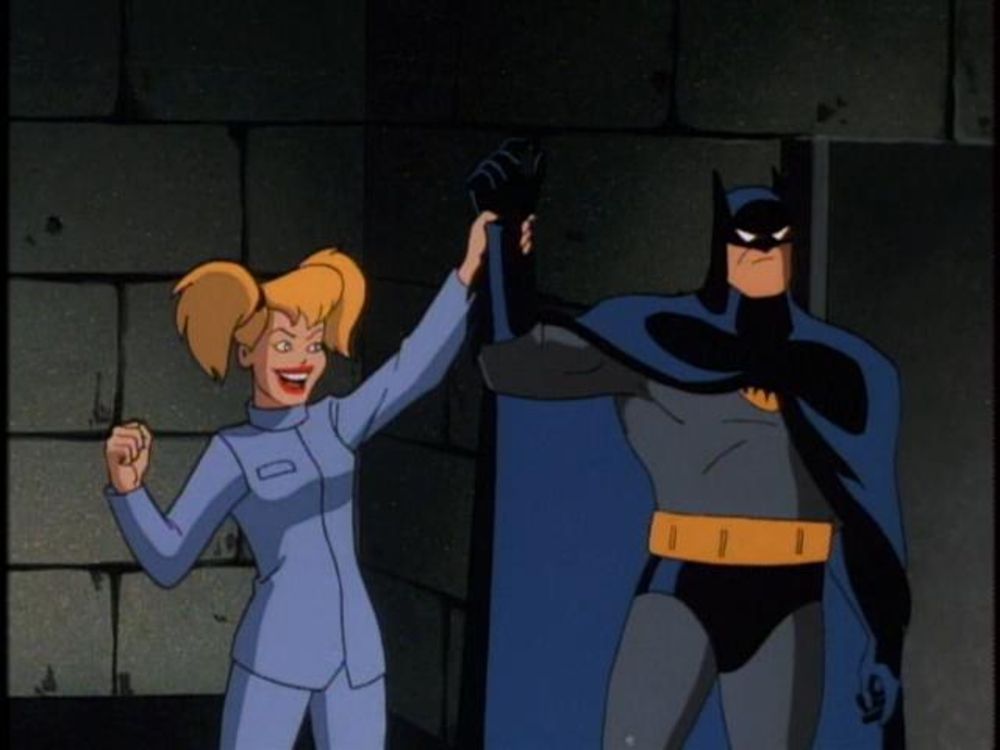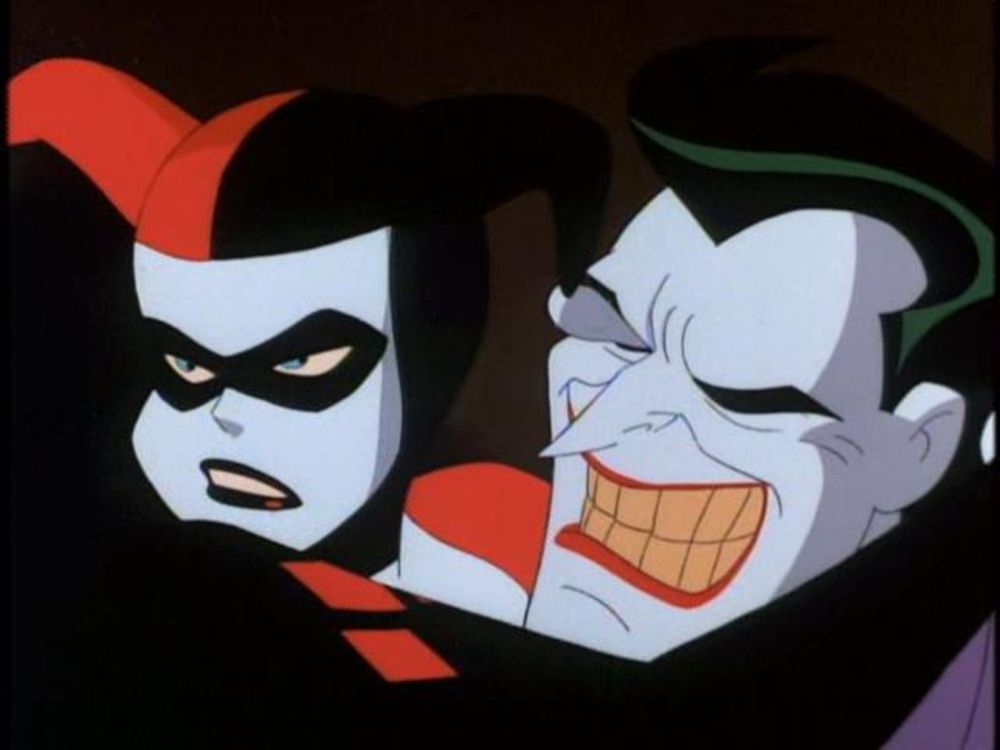Welcome to Adventure(s) Time's eighty-second installment, a look at animated heroes of the past. This week, we're looking back on Harley Quinn's first spotlight story, the tale of her aiding Batman in apprehending the Joker. Then, an issue of the tie-in book with the opposite premise--Harley attempting to revive the Joker's criminal urges!
Debuting on May 23, 1994, "Harlequinade" is written by Harley's co-creator Paul Dini, and directed by Kevin Altieri. The title card is an iconic Harley image, rendered by Eric Radomski. It's something that only appears onscreen a few seconds; one of dozens titles Radomski had to conceive for the show. But even in this brief moment, the striking image of Harley indicates she's more than a bit player now. The design, her personality, are striking. Visually, she's too intriguing to stay in the background.
The episode opens with the underworld auction of an atomic bomb. This is, frankly, nuts and the Joker hasn't even appeared yet. Within minutes, Joker's obtained the weapon, naturally. Mayor Hill refuses Commissioner Gordon's demand to evacuate Gotham. (Guess why?) Desperate, Batman and Robin travel to Arkham to recruit Harley's aid in stopping the Joker.
From there, Harley leads the heroes throughout Gotham, casually revealing little bits like the Joker's secret surveillance of the city's most powerful figures, like the Mayor. And, somehow, Batman and Robin always land in trouble whenever she leads the way. The finale confirms she always intended to betray them.
And Joker and Harley would've had a lovely reunion, if only Robin didn't remind her that his bomb's timer wouldn't have left Joker enough time to buzz Arkham and rescue Harley. Batman twists the knife deeper, pointing out the couple's pet hyenas would also die in the atomic blast.
Harley reverses her double-cross, freeing Batman and Robin. And while the heroes deal with the bomb, Harley faces a truly insane Joker. He's piloting his vintage aircraft directly towards the bomb, fully suicidal. (It's amazing how the zany, old Hollywood feel of the episode distracts from the more disturbing elements.) Harley causes the Joker to shoot his own fuselage, resulting in a much smaller explosion than he was expecting.
Another surprisingly dramatic moment closes the episode. As a dazed Joker escapes the wreckage, he's confronted by a machine gun-toting Harley. She's now prepared to kill the Joker, although he boasts she doesn't have the guts to shoot. Apparently, she does. Too bad for Harley (and all of Gotham), this is only a prank gun, complete with a "RAT TAT TAT" flag.
Harley's terrified of the Joker's response. But, his mood swings yet again. Joker embraces Harley amongst the flaming wreckage. (No symbolism here.) "Baby, you're the greatest!" he exclaims before both are returned to custody.
And while this is, in one sense, "illusion of change," it's hard to deny "Harlequinade" as a significant episode. For one, it's packed with memorable moments. Harley's performance of "Say That We're Sweethearts Again." Her removable hand gimmick. The Joker's snazzy "World War I flying ace" outfit. Harley's inability to name her close friends at Arkham. ("Lizard Man" and "Hat Guy.")
In terms of advancing Harley's character, however, "Harlequinade" is vital. Not only do we have the second hint of her past, when Batman reveals her previous role as a clinical psychiatrist, but an actual insight into her motives. Batman asks a question that wouldn't have seemed relevant, had she stayed a faceless henchgirl. "What's the attraction, Quinn? This sick infatuation with the Joker?"
Her answer is that, in her previous life, she was always listening to other people’s problems. When the Joker listened to her, she relished the attention. "He made everything fun," she tells Batman. He retorts, "You think it's funny when he hurts people?" She deflects with, "It's just a joke."
Really, that's the perfect line to let Harley off the hook. Goodness, she wouldn't actually want to hurt anyone would she? It's all for a laugh. Maybe the Joker takes things too far, but she understands deep down, he's still the wounded kid who spilled his guts to her. And how could she resist the freedom and excitement he's offered? (Harley has a telling line when donning her costume once again: "I feel like a human being again!")
Not that "Harlequinade" is a deep character story. It's mostly madcap antics, set pieces, and cute jokes. A smile covers Harley's tragedy.
More quirky humor follows in "My Boyfriend's Back", the third issue of 2003's revamped Batman Adventures series. Story and art come from the established team of Ty Templeton and Rick Burchett, with another amazing Bruce Timm cover. One of his best covers, actually.
Collectors slept on this comic for years, but it's now reaching outrageous back issue prices. (Along with many issues from this Batman Adventures volume.) Thankfully, the official digital version is easily affordable.
Following the continuity established in issue one, the Joker is apparently cured of his anti-social tendencies. And while Arkham succeeding in reforming its very first patient should be a cause of celebration, Harley is none too pleased. She misses her Joker, and is now determined to revive his true personality.
Her solution? To hire a hitman to murder him. She assumes placing Joker in a life-or-death situation will force his true personality to resurface.
It's a clever twist on their established dynamic. Harley is now the corruptor, the less sympathetic figure. Her motivation is to return to what she knows; the dynamic of Joker causing chaos while she cheers from the sides. Charitably, we could say this is an abuse victim returning to her familiar role. Alternately, we could decide Harley's become just as twisted as her lover.
Any assassin would've fit the story's needs, but Templeton wisely references an ongoing mystery from this run. It appears Ra's al Ghul has sent his Society of Shadows to murder Batman's rogues gallery. And one of those assassins is currently in police custody.
Harley frees the assassin, taking him to their lair. The new pacifistic Joker is no match for him.
Joker's life is saved by Batman, who appears just in time. Frustrated, Harley goes for the nuclear option. She pulls Batman in for a passionate kiss, hoping to arouse the Joker's jealousy.
The plot works, creating enough psychic distress to undo the months of intense therapy. Joker's back to his true self...just in time for Batman to eventually pull out the victory, leaving both Harley and Joker for the recently arrived GCPD.
THE WRAP -UP
CONTINUITY NOTES
Harley jokes with Batman that she's not even a natural blonde. Paul Dini, years later on Twitter, would affirm she is quoting an old joke, and is in fact blonde. (Thanks to the DCAU Wiki for pulling that quote.)
Mobster Boxy Bennett debuts in "Harlequinade". He only makes two appearances on the show, but Ty Templeton resurrected him for the tie-in books.
Fans of Renee Montoya might be interested to know that, as of Batman Adventures #3, she now has a Captain ranking within the GCPD. She's come quite a way since being introduced as a uniform cop in the earliest episodes. (Given how fast she's advanced, you've got to wonder just how many years have passed since those early stories.)
HEY, I KNOW THAT VOICE
Veteran character actor Dick Miller voices Boxy Bennett. He's likely best known for playing Murray Futterman in the Gremlins films, but really, Miller was in practically everything from the '60s to the '90s. He even had a role in Pulp Fiction that was cut for time.
OVER THE KIDDIES' HEADS
The average kid likely won't pick up on the references to old Hollywood in "Harlequinade." "Say That We're Sweethearts Again" comes from the 1944 film Meet the People. Fred Astaire is apparently the model for the pianist performing the song. Much of the physical humor comes from old Looney Tunes gags. And Joker's closing line to Harley is a nod to The Honeymooners.
LIFE USED TO BE SO PLACID...
It's interesting to see just what the audience will accept from Harley. She can agree to help Batman hunt down the Joker, and no one views her as a traitor. She can double-cross Batman at the end, and the viewer simply views it as a logical plot twist. And she can dedicate herself to undoing Joker's therapy, recreating this monster, and it's played as a cute game.
Humor allows the audience to forgive a lot. And to overlook the darker implications of Harley's relationship with the Joker. In "Harlequinade," Batman has the best line to dismiss her "it's all for fun" deflection: "Hope you're still laughing when it's your turn."
Traditionally, the show dances around this aspect of their relationship. Harley's, ultimately, just one more victim of the Joker. Any attempt on her part to elevate herself past that is a sad delusion. But, if played correctly, the stories can balance that tragedy with healthy doses of the absurd.
So that’s all for now. If you have any suggestions for the future, just leave a comment or contact me on Twitter. You can also check out some of my fiction writing for free over at Smashwords.

